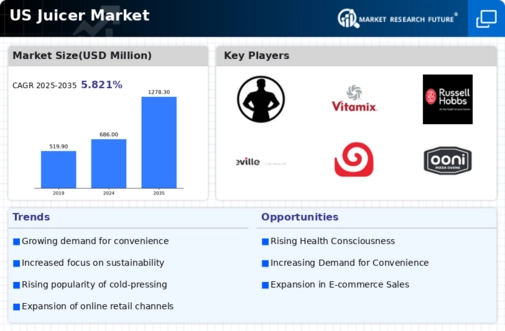Convenience and Portability
The fast-paced lifestyle of modern consumers is driving the demand for convenient and portable juicing solutions within the juicer market. As more individuals seek quick and easy ways to prepare healthy beverages, compact and user-friendly juicers are becoming increasingly popular. Recent data suggests that portable juicers, which can be easily transported and used on-the-go, are experiencing a surge in sales, particularly among younger demographics. This trend indicates a shift towards products that cater to busy lifestyles, with features such as rechargeable batteries and easy cleaning mechanisms. The juicer market is thus adapting to these consumer preferences, potentially leading to the development of innovative designs that prioritize convenience without compromising on quality.
Innovative Product Features
Technological advancements in juicer design and functionality are significantly impacting the juicer market. Manufacturers are increasingly integrating features such as smart technology, which allows users to control juicing processes via mobile applications. This innovation not only enhances user experience but also appeals to tech-savvy consumers. Additionally, the introduction of multifunctional juicers that can also blend, chop, and puree is gaining traction. According to recent market analysis, the segment of high-end juicers with advanced features is expected to account for over 30% of total sales in the coming years. The juicer market is thus evolving, with brands competing to offer unique functionalities that meet diverse consumer needs, potentially leading to increased market share for those who innovate effectively.
Rising Health Consciousness
The increasing awareness of health and wellness among consumers appears to be a primary driver for the juicer market. As individuals seek to incorporate more fruits and vegetables into their diets, the demand for juicers has surged. Recent data indicates that the market is projected to grow at a CAGR of approximately 6.5% over the next five years. This trend is likely fueled by a growing preference for fresh juices over processed beverages, as consumers become more discerning about their nutritional intake. The juicer market is thus witnessing a shift towards products that promote health benefits, such as cold-pressed juicers, which retain more nutrients. This heightened focus on health is expected to continue influencing purchasing decisions, leading to an expansion of product offerings that cater to health-conscious consumers.
Increased Online Retail Presence
The expansion of e-commerce platforms is significantly influencing the juicer market. As consumers increasingly turn to online shopping for convenience and variety, the availability of juicers through digital channels is on the rise. Recent statistics reveal that online sales of kitchen appliances, including juicers, have grown by over 25% in the past year. This shift is prompting manufacturers to enhance their online presence and invest in digital marketing strategies to reach a broader audience. The juicer market is thus likely to see a transformation in sales strategies, with a focus on optimizing online customer experiences and leveraging social media to engage potential buyers. This trend may lead to increased competition among brands as they strive to capture the attention of consumers in a crowded online marketplace.
Environmental Sustainability Initiatives
The growing emphasis on sustainability is becoming a crucial driver for the juicer market. Consumers are increasingly inclined to purchase products that align with their environmental values. This trend is reflected in the rising demand for juicers made from eco-friendly materials and those that promote waste reduction, such as models that utilize whole fruits and vegetables. Recent surveys indicate that approximately 40% of consumers are willing to pay a premium for sustainable products. As a result, manufacturers are focusing on sustainable practices in their production processes, which may enhance brand loyalty and attract environmentally conscious buyers. The juicer market is thus likely to see a shift towards greener product lines, as companies strive to meet the expectations of a more environmentally aware consumer base.

























Leave a Comment